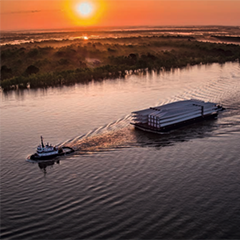Anyone familiar with the current offshore wind (OSW) project pipeline along the United States’ East Coast, knows that this undertaking has great potential to turn into the envisioned one trillion-dollar industry in the coming decades. The current plan is to install 13 offshore wind farms totaling 9.1GW power output by 2026 [AWEA Status Update 2020], with industry experts predicting to overtake the European market 20 years from now.
This ambitious project poses an immense challenge, but also a once-in-a-lifetime opportunity for the entire American waterfront. Are we ready to handle the world’s largest offshore wind turbines, and how can we bridge existing gaps between industry expectations and currently available cabotage compliant solutions? Lessons learned from the existing U.S. onshore wind industry can help us to provide the skillsets necessary. Today we hear from SEA.O.G. Offshore about their perspective on OSW’s future in the U.S. and their plan to use onshore industry experience to move offshore wind forward.
From onshore to offshore
With more than 60,000 onshore turbines planted across 41 states, wind has already become the most significant renewable energy source in the United States. As of January 2020, the total installed wind power nameplate generating capacity in the United States was 105,583 megawatts, a capacity exceeded only by China. With such expansive growth on the horizon, two companies had an idea to come together to fill the existing gap between marine and port operations. In 2019, SEA.O.G. Offshore was established as an integrated service provider for the United States’ offshore wind sector.
The joint venture brought together Gulf Marine Contractors (GMC), a leading marine agency and offshore logistics provider in the Gulf of Mexico, and SEA.O.G., a full-service engineering and heavy lift management firm for the U.S. onshore wind industry.
‘SEA.O.G. had a reputation of contributing to the advancement of the renewable energy industry within the U.S.,’ says Clark Buffam, Chief Operating Officer of GMC. ‘We knew they were a household name in the industry and had unparalleled experience in WTG handling and transportation.’






























